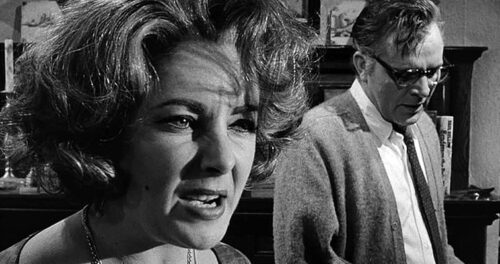[8]
An associate History professor (Richard Burton) and his wife, the university president’s daughter (Elizabeth Taylor), invite a new biology faculty member (George Segal) and his wife (Sandy Dennis) to their house for drinks. But the evening goes hellishly south when the older couple begin airing marital grievances, including the whereabouts of their son on the eve of his sixteenth birthday. By sunrise, nasty games and hidden truths will bring one couple closer together and one couple further apart.
Who’s Afraid of Virginia Woolf?, based on the play by Edward Albee, is the best example of how to adapt material from the stage for the big screen. Director Mike Nichols (The Graduate, Working Girl), in his auspicious film debut, opens the story up visually and uses the camera to bring us directly into the turmoil. Haskell Wexler turns faces into compelling cinematic vistas here. No camera angle is lazy or uninspired, and there’s an unusual amount of camera movement for a stage play interpretation — keeping the script’s raw primal emotions ever-flowing. The result is a directing and photographic style that mirror the writing style — bold, energetic, and dangerous.
The casting of real-life on-and-off-again lovers Taylor and Burton seemed like a marketing stunt at the time of the film’s making, designed to garner a lot of press coverage leading up to the film’s premiere. Well, it did that. But the gimmick works — Burton and Taylor are on fire and you can’t stop watching them. Taylor, despite being too young for the part, gives one of her most compelling performances as the increasingly drunk and vitriolic Martha. The only thing more remarkable than her unfettered monstrosity is what Nichols gets from her in the final act — an astute psychoanalytic monologue followed a complete reversal in her power struggle with Richard Burton. Burton is equally impressive as George — seemingly cool and controlled, but indicating from very early on that he has the potential to explode and take everyone with him.
Albee, Nichols, and these two acting titans succeed in humanizing these characters, highlighting how true love and true hatred can be two sides of the same coin. George Segal and Sandy Dennis hold their own in two great supporting turns, playing a couple that may appear outwardly more respectable… but let’s see how they survive the night. The film is also significant for being the first American studio film to feature profanity, effectively ending the Hays Code that governed Hollywood censorship since the 1930s, and leading to the creation of the Hollywood rating system that we still use today.
Academy Awards: Best Actress (Taylor), Supporting Actress (Dennis), Black & White Cinematography (Haskell Wexler), Black & White Art Direction/Set Decoration, Black & White Costume Design
Oscar Nominations: Best Picture, Director, Actor (Burton), Supporting Actor (Segal), Adapted Screenplay, Film Editing, Score (Alex North), Sound

